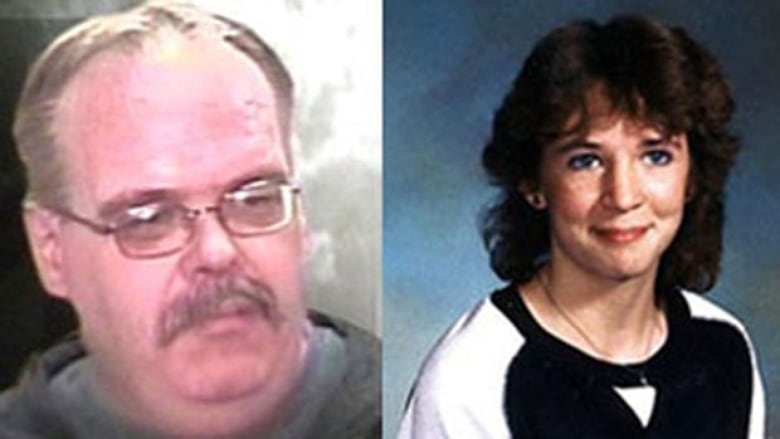Candace Derksen retrial: Retired officer recalls mistake in original testimony
Retired police officer says he realized 2 weeks ago he put DNA evidence in a box for film, not an evidence bag

A retired police officer testified today in the retrial for Candace Derksen's killing he "woke up in the middle of the night" two weeks ago recalling that his previous testimony was inaccurate.
Robert Parker was an identification officer with the Winnipeg Police Service in 1985. After a lengthy search, Candace Derksen, 13, was found dead on Jan. 17, 1985. She was found tied up inside a rarely used machine shed by employees at an industrial yard.
- DNA evidence questioned at 1st day of retrial
- Lawyer argues later kidnapping was 'strikingly similar'
Parker was responsible for escorting the girl's frozen body to Seven Oaks General Hospital in Winnipeg and attending the autopsy.
It was also his duty to photograph her autopsy and "seize" and "bag" any items turned over by the medical examiner which would later become police exhibits.
On Wednesday morning — the retrial's third day — Parker testified he woke up two weeks ago realizing he did not in fact "bag" the twine used to tie up Candace but in fact placed it in a box that had been previously used to store film.
"Quite honestly, what was bothering me the most is I was going over transcripts over previous testimony [and asking myself], 'Was I absolutely sure?,'" Parker said, referring to previous testimony that he would have bagged the twine.
He settled on the fact that he in fact put it in a photograph box, which he said was "very common" practice at the time.
During cross-examination, Grant's defence lawyer questioned Parker on the accuracy of his police notes and labelling of exhibits at the time of the investigation, but did not specifically challenge him on placing the twine in a box rather than a bag.
The twine turned out to contain evidence crucial to laying charges against Grant. A forensic specialist called on by the Crown linked the DNA to Grant and said there was a one in 50 million chance it belonged to anyone other than the accused.
A jury found Grant guilty of second-degree murder in 2011. Two years later, a Manitoba Court of Appeal judge ordered a retrial because evidence about a possible "third-party suspect" was withheld from jurors during the first trial.
The Crown asked Parker Wednesday why he recalled putting the twine in a box 32 years later. He responded that he was "not sure."
Girl found frostbitten
Parker told the court when Candace was found, her body was "completely frozen".
"The clothing on the body was quite soiled with what appeared to be a dirty material," he told the court. "The deceased's face appeared to be quite frostbitten."
Some of the items police seized at the autopsy included a clear plastic shroud that covered Candace's body during her transport to hospital.
Other items included her jeans, her jacket — which contained sticks of gum — and a white metal ring with a heart-shaped stone in the pocket, Parker said.
The shroud, jeans and jacket were presented by the Crown inside individual plastic bags on Wednesday.
During the defence's cross-examination of Parker, he was questioned regarding his knowledge of DNA in 1985 and the steps he took to protect the integrity of the scene.
"The protective clothing that was worn at the time was nil," Parker testified, adding as a plain clothes officer he was wearing his clothes of the day.
There were no DNA protocols in 1985, he said.
Retired officer Don Ogilvie, who worked with the RCMP's hair and fibre unit in 1985, testified later on Wednesday that he used tweezers to pull the forensic evidence from police exhibits, including two large tree stumps found in the shed and Candace's jacket, jeans and right sock. Ogilvie said he then mounted the hair and fibres onto slides for analysis.
Ogilvie said while doing so, he would typically wear a fresh lab coat and gloves, and clean his work space between mounting each slide to avoid any contamination of evidence. He could not recall whether he wore gloves while examining the twine evidence and said he would not have worn a mask.
During his cross-examination, Ogilvie added the twine evidence arrived in two plastic bags.
Masks not worn during autopsy
The defence also raised the point that masks were not worn at the scene where Candace was found or at her autopsy.
Parker testified he was shown a video recording of the 1985 autopsy for the first time two weeks ago.
The judge-only retrial began on Monday and is presided over by Justice Karen Simonsen. Brent Davidson and Michael Himmelman are acting for the Crown and Saul Simmonds is representing Grant.
On Thursday, the court expects to hear from Robert Chisnall, a knot specialist; John Burchill, a Winnipeg police criminal analyst; and RCMP scientists Tod Christianson and Pamela Dixon.
